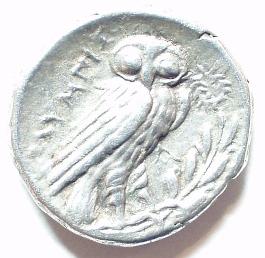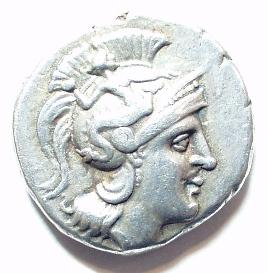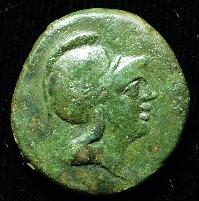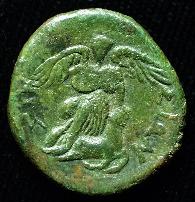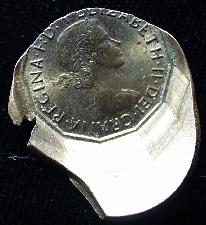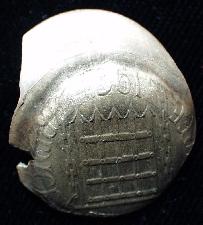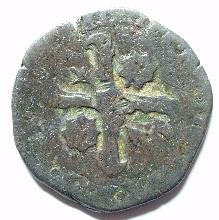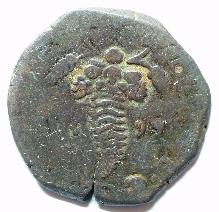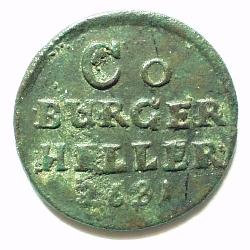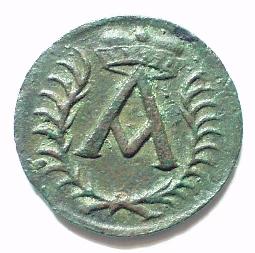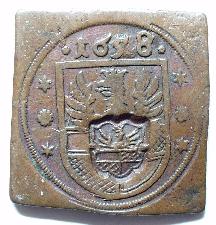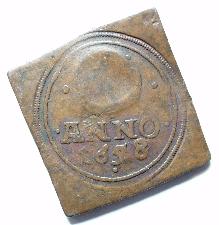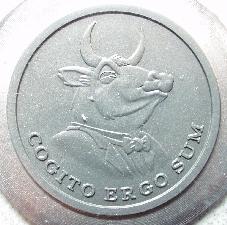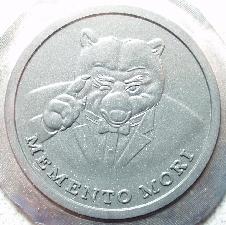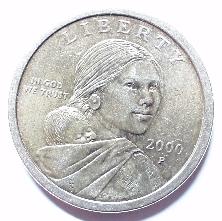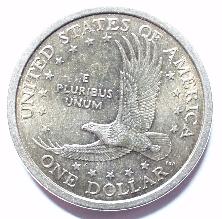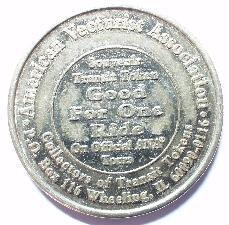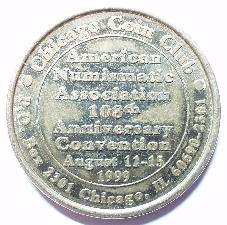Chatter
archive
also available
| Chicago Coin Club |
|---|
| Volume 46 No. 6 |
June 2000 |
|---|
Editor's Notes
This issues's Show and Tell article is illustrated!
The printed Chatter contains only those grayscale
images which print nicely,
while the on-line Chatter contains color images
with each image being a link to a larger-sized image.
Although some colors are off (the Sacagawea
dollar is really more golden in color),
the images are sharp enough to see the lint
and dust on some pieces.
But the images of paper money did not turn out at all,
mostly because I practiced on worn coins.
(A proof silver medal had such mirror-like fields that the
image in the camera's view finder included the small
printing near the edge of the camera lens!)
The URL is http://www.ece.iit.edu/~prh/coins/chatter/Jun/
and the images are best viewed with a setup that supports
true-color (also called 24-bit color, or 16-million
possible colors).
Next time, a small millimeter scale will be located
diagonally in some corner of each image.
Paul Hybert, editor
Minutes of the 976th Meeting
The 976th meeting of the Chicago Coin Club was called
on May 10, 2000, 7 PM, Bank One, 18th floor by president Carl Wolf.
With the exception of typographical errors,
minutes from the prior meeting were approved.
The treasurer's report was read and approved.
Guests for the evening were Sharon and Kevin Blocker from Oak Park, IL.
First VP Steve Zitowsky introduced our featured speaker for
the evening, member Bob Feiler.
Bob's topic was
Odd Denomination Notes and Scrip.
Bob displayed a whole range of odd denominations of U.S.
paper money staring with low values and working to higher values.
At the conclusion of his talk, Bob was presented with the ANA
Educational Certificate award and the club Featured Speaker medal.
Exhibitors for the evening were as follows:
- Bill Swoger - Old reference books on ducats, 1752 ducat
- Mark Wieclaw - 1921 Mexican peso, owl coins, 1880 Morgan dollar
- Don Dool - 1599 Naples bronze, 1681 heller, Baleric Islands coin
- Carl Wolf - Souvenir sheet ABN Co Artisan Bank, NJ
- Jeff Rosinia - Old coin holders and folders
- Mike Metras - Sacagawea dollar 2000, ANA transportation token,
Confederate note
- Bob Feiler - Simulated 1909-S Lincoln cent, saving society bond coupon
for $3 in gold coin
There was a second reading of membership for Satya Bhupatiraju,
Michael Schmidt, and Russell F. Wajda and they were subsequently
approved for membership.
Also, there was a first reading of membership for Sharon and Kevin Blocker.
Under old business, minutes from the board of directors of
April 26th were published in the May Chatter for members to review.
The metallic life membership cards are in and since Mark Wieclaw
donated the costs, Carl presented the first card to Mark.
Cards were then presented to the other life members present,
Carl Wolf and Bill Burd.
Mark Wieclaw was also presented with the ANA Presidential Award lapel
pin following the original presentation to Mark at CICF by Kermit Wasmer.
Under new business, mention was made of Bob Leonard's article
on primitive money in the May 8th issue of
Coin World
and Steve Feller's article on internment camp currency in the May
issue of
The Numismatist.
Don Dool mentioned that he has been writing a series of monthly
columns on coins of conflict published in
World Coin News.
Members said farewell to Mike Steffens
for awhile as he is relocating to Scottsdale, Arizona later this month.
Meeting adjourned 8:51 PM.
Respectfully Submitted,
Richard Hamilton
Secretary-Treasurer
Speaker's Wor[l]d
Odd Denomination Notes and Scrip from the United States
Our featured speaker, member Bob Feiler, summarized
his interest in this material as follows:
What I find interesting about obsolete currency and odd denominations notes
and scrip is the vast assortment which is still available to the average
collector on a budget. It is possible to make and build a collection with as
many or as few notes as one would like.
Odd denomination notes and scrip can be obtained from
thousands of issuers with very fanciful and decorative designs and vignettes.
His collection of odd denomination notes was started when he spotted,
at a local coin show, a $3 bill that he just had to buy.
The dealer then explained that a host of other unusual amounts could be found
on bills and scrip, including a $4 bill.
That encounter "set the hook" and kindled his interest in obsolete
and odd denominations.
One of his first notes was an unissued $3 (remainder)
note from the mid 1800s
which featured a backwoods pioneer with his
horse and dog.
The man is depicted bending down to drink from a stream.
One of his favorite notes is the $2.50 Illinois and Michigan Canal fund note
from the 1840s
which has a cross eyed buffalo as the central vignette.
There are only a few references devoted to obsolete denomination bank notes and scrip.
One is Denominations by Roger Durand, and the other is
Odd Bank Note and Scrip Denomination in American Monetary History
by John A. Muscalus.
There are annual price lists by Hugh Schull in addition to the listings
scattered throughout the references by Haxby and Criswell.
After displaying many colonial-era notes with apparently odd denominations,
Bob and the audience discussed the exchange rates between the different colonies.
Although the term dollar generally referred to the Spanish 8 reales piece,
the currency of most colonies was denominated in
pounds, shillings, and pence.
But the tricky part is that different colonies valued their
shillings differently against the dollar.
That helps us understand the existence
of notes bearing such denominations as
one-ninth dollar, two-ninths dollar, and one-sixth dollar.
Some of the denominations of Pennsylvania notes shown were
two shillings and six pence, 3 shillings, 6 shillings, and 14 shillings.
Along with warnings against counterfeiting,
Bob pointed out some of the anti-counterfeiting measures
taken in the colonial era.
Such as a tobacco leaf reverse,
fine pieces of mica embedded in the paper,
and secret marks and mis-spellings.
Most of the odd denominations notes from the 19th century
were issued by the many private and
state-chartered banks, railroards, and insurance companies
then in existence.
These are usually called broken-bank or wildcat notes.
The local scrip issued in the 20th century provided
the last examples of odd denominations in Bob's presentation.
These notes typically have a low denomination, valued
in either cents or fractions of cents.
Issues from Moline, Illinois valued at one-eigth and five-eights
cent were shown,
along with issues from the First National Bank of Plaza, North Dakota
valued at one-half, one and one-half, two, and four cents.
Although mostly of a souvenir nature nowadays,
the scrip from the depression-era met an actual need,
as did the one cent food stamp program refund piece dated 1969.
Show and Tell
-
Bill Swoger
started this session with a 1752 gold ducat from Waldeck.
The piece is not listed in Krause or Friedburg.
He also showed a two-volume 17th century reference
work on gold coinage, and told how he acquired them.
-
Next was
Mark Wieclaw
with a wide assortment of items:
-
Mexico 1921 50 Peso - the key date of the series
with only 180,000 minted.
-
A silver drachm of Tareton, with an owl one side and
Athena on the other side.
-
A bronze from Syracuse, with an Athena obverse and
a reverse of Nike seated on a bull.
-
British 1964 3 pence capped die error.
This is viewed with suspicion because it shows
many simultaneous errors and because many such
specimens appeared on the market at the same time.
They were allegedly struck by a mint employee.
-
1880/79 CC US Morgan dollar and a photo of the
overdate taken through a microscope.
Mark invited club members interested in having
such photos taken of their coins to contact him.
-
Don Dool
likes those early copper coins,
and showed us:
-
Naples & Sicily, 1599, Cinquenta, Phillip III of Spain, 1598-1621.
Eklund 356.
The obverse shows the cross of Burgundy with flames in angles.
while a cornucopia divides the date on the reverse.
-
Sachsen-Coburg, 1681, Heller, Albert II, 1680-1699.
Grasser 394; Eklund 1223.
The obverse bears a crowned A between crossed palm branches,
while the reverse is rotated 45°.
-
Hildesheim, 1658, Muhlenzeichen (Mill tax token) (also listed in
Mailliet as an emergency issue?)
About 30 entries in Neumann.
In Friedrich Freiherr von Schroetter's
Woeterbuch der Muenzkunde,
the meaning of muhlenzeichen (as translated by Chris Ehrhardt
of New Zealand) is given as:
"Tokens which had to be handed over at the mills in payment
of the grain-milling tax.
Occur in the 16th and 17th centuries in Minden,
Dortmund, and above all from 1600 to the beginning
of the 19th century in Hildesheim, where they were
systematically organized, with a different metal for each
sort of grain and a different shape for each quarter of the city,
and the amount was indicated by the number of corn-grains marked on each."
-
Ibiiza (Spain-Balearic Islands), 1686, 12 Dinereos, Graded fair by
Canadian dealer
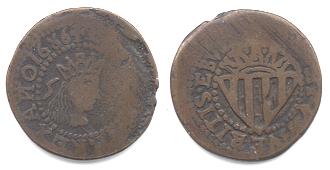
-
Tournai, 1709, 2 Sols, shown for comparison of grading to above,
graded fine by European dealer

-
Continuing his theme of of Souvenir Sheets bearing replicas
printed from the original plates,
Carl Wolf showed a $10 note from the
Artisan Bank of Trenton, NJ (1857-1858).
The vignettes on their notes refer to craftsmen such
as the mechanic and shipbuilder on this note
originally printed by Danforth, Wright & Company, one of the
firms that eventually merged to form the American Bank Note Company.
The ABNC printed this replica on a larger intaglio printed sheet
that served as a souvenir receipt for a $10 contribution to the
American Numismatic Association's building fund of 1981.
Carl next showed sovenir rounds from a banquet sponsored
by Tudor Investment Group in 1982.
The main design elements were a tuxedo-wearing bull and bear,
with the phrases Cogito Ergo Sum (I think, therefore I am),
and Memento Mori (Remember your mortality).
The lead trial strikes appear below.
-
Long-time area residents took a trip down memory lane with
Jeff Rosinia
as he showed the coin holders issued by various banks
and Savings and Loans in the 1950s and 1960s.
Somewhat reminiscent of the Whitman "penny boards,"
these were promotional items used to encourage people
to save the minimal amount to open an account.
They were issued in dime versions and quarter versions
to reach the $3 or $5 filled value
(and one from the Northern Trust Bank would hold folded
dollar bills to reach a larger amount!).
Holders were from
Exchange National Bank,
Evanston Trust,
Cook County Federal Savings,
Harris Bank,
Northern Trust,
Gateway National Bank,
First Federal Savings,
Admiral Savings,
Bell Savings,
and Home Federal Savings.
How many of those names do you remember?
Jeff also showed some of the state quarter coin holders
that are currently available.
-
Mike Metras
showed two pocket pieces and some Confederate Notes.
-
Sacagawea dollar showing some loss of luster.
-
ANA transportation token form the 1999 convention in Rosemont.
Mike will show us these pieces in the future so we can
see how they wear down.
-
100 dollar note from Richmond, payable 6 months after peace.
It bears a postal marking from Jackson, Mississippi and
interest-paid stampings from January of 1863, 1864, and 1865.
-
20 dollar note from Richmond, payable 2 years after peace.
-
The last exhibitor was
Bob Feiler
with an oversize Avon lip gloss container as an oversized
1909-S VDB Lincoln cent.
He also had a $4 (unusual denomination) note from the
Equitable Savings Society (date 1900),
and a February 1st 1929 $3 bond coupon note from the
Pioneer Trust and Savings Bank.
The wording on the coupon is unusual:
"Lawrence L. Veit, a bachelor and Regina Hans Wolins
and Leo Wolins, her husband promise to pay to the bearer"
$3.00 in Gold Coin.
Harry Flower
Albert Einstein once said: "God does not play dice."
He referred to the order of nature and the quantum theory.
In many respects, with a little imagination,
a similar phrase could be applied to Harry Flower,
Pharmacist, Numismatist, Gentleman and Friend.
When Harry began to collect some new aspect of coins,
the order of his approach increased in a quantum fashion
as he pursued his acquisitions of the coins and of the
historic information about them.
Thus, he followed in the path of his life-long idol, Albert Einstein.
Harry Flower, 87, passed away on May 24 of a heart related condition,
in Grand Junction, CO where he and his wife Bess have lived in
a retirement village for the past three and one-half years after
leaving a 20 year residency in Wheaton, IL.
He is survived by Bess, a son, Mark (Kenda Vaughn),
a daughter, Phyllis and three grandchildren.
Harry grew up in Lexington, KY and attended the School of Pharmacy
at the University of Illinois, Chicago.
He had his own pharmacy for 30 years, which he maintained until
his partial retirement in the early 1990s, but continued to apply
his pharmacy experience working part-time for several downtown
pharmacies.
Harry and Bess were longtime members of the West Suburban Congregation
in Oak Park, IL.
Numismatically, Harry had one of the world's largest collections
of coins and medals featuring Albert Einstein,
including several pieces which were made specifically for him.
He authored the definitive catalog on Einstein coins and medals
and, in addition, had a large collection of ephemera devoted
to the life and times of Einstein.
Harry also authored the book
Tokens and Medals Issued by Israel Numismatic Society.
A prayer book includes the line: "Lord, let me know mine end,
and the number of my days that I may be certified how long I have to live."
This was never a concern to Harry, who simply lived to the fullest
every day of his life in pursuit of his interests.
Harry Flower joined the Chicago Coin Club in 1958 (No. 695) and
remained an active member until leaving for Grand Junction.
He was a founding member of the Hillside Coin Club and of
the Israel Numismatic Society of Illinois, and was associated
with the Oak Park and Morton Grove Coin Clubs.
At the National level, Harry was a member of the American Israel
Numismatic Association and the American Numismatic Association.
He authored a number of manuscripts for The Shekel (AINA)
and The Numismatist (ANA) and other journals.
Among the many awards received by Harry Flower over the years
was his appointment as a Numismatic Ambassador by Krause Publications.
So thorough was Harry's pursuit of his numismatic interests that
it has been said that he needed three copies of every coin,
one to show the obverse, one for the reverse, and one for the edge.
He began collecting in 1928.
In addition to his interest in things related to Einstein,
Harry generated a large collection of items manufactured from coins,
including coin boxes, fobs, ash trays, spoons, etc.
A graveside service was held in the West Suburban Temple Section
of Glen Oak-Oak Ridge cemetary in Hillside, IL on Tuesday, May 30.
Saul Needleman
Our 977th Meeting
| Date: | June 14, 2000 |
| Time: | 7:00 PM |
| Location: | Bank One Plaza Building
(formerly the First National Bank Building)
18th Floor, on Dearborn between Madison and Monroe.
Enter the building at the South entrance of the Dearborn side,
sign in at the security desk and take the elevator to the 18th floor. |
| Featured speaker: | Robert Weinstein
- The Coinage of the Sakas |
| |
Saka was the name by which the Scythians refer to themselves.
These were a nomadic people who are first mentioned in history in
the 8th Century BC as raiders and plunders of Greece,
Persia, Egypt and Assyria.
They were held together by a common language and culture that reached
from Eastern Europe to the borders of China.
Within numismatics perhaps the most commonly known Scythian
subgroup was the Parthians.
Join Mr. Weinstein as he shares with members examples of the diverse
coinage from these people (300 BC - 300 AD) and gives an
update on the latest research in Indo-Scythian numismatics.
|
Important Dates
| Jun | 14 |
CCC Meeting - Featured Speaker - Bob Weinstein on
The Coinage of the Sakas.
|
| |
| Jun | 23-25 |
19th Annual Mid America Coin Exposition
at the Rosemont O'Hare Expo Center.
Adults pay $5 for a two-day admission pass good Friday and Saturday,
and children 12 and under pay $1.
There is free admission on Sunday.
|
| |
| Jul | 12 |
CCC Meeting - Featured Speaker - Kevin Dailey with
The Numismatic `Jeopardy' Game. |
| |
| Aug | 9 |
CCC Meeting - Featured Speaker - Cliff Priest on
Chicagoland Stock Certificates. |
Birthday and Year Joined
| July | 4 | Chester Poderski |
| July | 12 | Flemming Lyngbeck Hansen | 2000 |
| July | 13 | Gerard Anaszewicz | 1981 |
| July | 19 | Terry L. Capps | 1996 |
| July | 19 | John R. Connolly | 1997 |
| July | 19 | Richard S. Hamilton | 1986 |
| July | 20 | Kermit W. Wasmer | 1986 |
| July | 27 | David Simpson |
Chatter Matter
All correspondence pertaining to Club matters
should be addressed to the Secretary and mailed to:
CHICAGO COIN CLUB
P.O. Box 2301
CHICAGO, IL 60690
Visit Our Web Site
http://www.ece.iit.edu/~prh/coins/ccc.html
Contacting Your Editor
Paul Hybert
ECE Dept, IIT
3301 S. Dearborn
Chicago, IL 60616 |
| prh@ece.iit.edu |
| 1-312-567-3976 |
Club Officers
| Carl Wolf | - President |
| Steven Zitowsky | - First Vice President |
| Robert Feiler | - Second Vice President |
| |
| Directors: | Paul Hybert
Mike Metras
Jeff Rosinia
Mark Wieclaw |
| |
| Other positions held are: |
| Richard Hamilton | - Secretary Treasurer |
| Paul Hybert | - Chatter Editor |
| Phil Carrigan | - Archivist |
